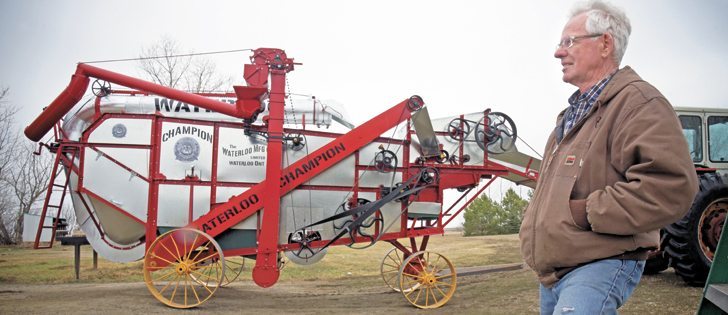ALLAN, Sask. — Rick Steffen knows it’s better to wear out than rust out.
“Absolutely,” said the retired farmer who has recently finished restoring his 1919 Waterloo Champion threshing machine at his home shop near Allan, Sask.
“The thing about wearing out is that you can replace the wore-out part. When it’s rusty it’s usually the whole machine that’s going to rust.”
Exposed to the elements, with a century of corrosion, dust and decay, the vintage harvest machine was dismantled piece by piece.
Read Also

Saskatchewan throne speech promises strong economy
Saskatchewan’s legislative agenda for the coming year will focus on meeting the challenges of new world trading relationships, said the speech from the throne.
Steffen then cleaned and rebuilt all of it by hand, which involved more than 1,000 parts.
With about a year of labour and his own money, Steffen has restored the thresher to its original glory.
It is in as good of shape or better shape than the day it was rolled off the factory floor in Waterloo, Ont., at the end of the First World War.
Steffen grew up in the 1950s near Muenster, Sask., and remembers watching his grandfather, father and uncles operate their Case thresher while it harvested wheat, barley and oats.
“I was always amazed at how the thresher worked,” he said.
By the time he was about eight years old, their thresher had been replaced by a self-propelled combine.
Indeed, during the 1940s and 50s most of the prairie dinosaurs were left to rust at the edges of farmer’s fields.
Today they can be found behind weathered barns, beside crooked fence lines, or heaped with other antique relics at rural museums.
Steffen chose to rebuild the Waterloo model because it was in the best condition of those at an auction he attended in 2009. He had the highest bid of $35.
After an extensive search, he discovered there were no manuals available for Waterloo threshers, although he found many for Case, John Deere and McCormick.
Lack of detailed drawings did not hinder the rebuild, he said, but he had to guess at the dimensions of wooden pieces.
“All the threshing machines are basically the same principle — just different styles,” he said.
Components included the straw walker, sieves, main cylinder, straw blower, grain elevators, bushel counter, bushings, shafts, pulleys, belts and gears.
About 200 square feet of new galvanized sheet metal panels were shaped and fitted. Several gallons of red and green paint were sprayed and original looking logos where custom made and glued on.
The straw walker posed a unique challenge because most of it was built from hardwoods.
However, enough clues remained for Steffen to figure out how to rebuild it.
His workflow consisted of taking off pieces, rebuilding, painting and setting each aside before painstakingly fitting it back together.
It was during disassembly that Steffen was struck with the power of rust.
‘Getting pulleys off shafts they had to be heated up and I had to use really heavy hammers. Most of it was heating it up until it was red hot, just to break the rust,” he said.
“I broke the main drive pulley trying to get it off. It was heated up as much as I could and it still broke.”
Although he could have a new pulley machined, Steffen found a used one from another in Waterloo.
As far as he knows, his thresher may be the only one in Western Canada that has been totally restored.
“I don’t know if anybody has actually gutted one and started over. Most of them are just fixed up,” he said.
“It actually costs quite a bit and they’re not used as equipment anymore. They’re only used as a hobby and a show.”
Throughout the country threshers are pulled out and greased once a year during local harvest events, usually by old-timers eager to show how grains were once separated from the stalk before the advent of modern combines.
Steffen understands that most people are more interested in rebuilding tractors, but the actual harvesting machinery hold more fascination with him.
“I like the combination of metal and wood. The threshing machine is a good example of that because the whole inside is made out of wood,” he said.
“This is something that I really like to do and I think I’m going to do a binder next.”
















